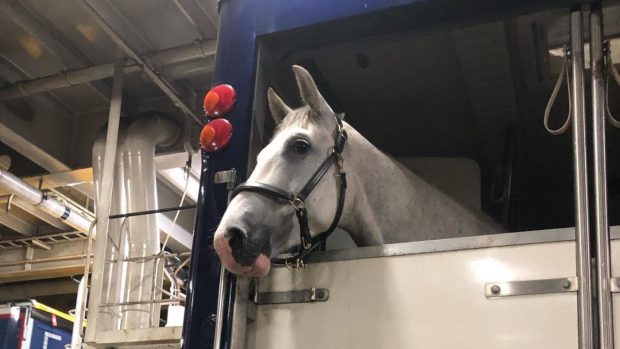Few owners are aware of the potential dangers of shipping fever in horses, believing that they are protecting their horses on a journey by bandaging limbs, supplying haynets, making sure the horses are safely secured and checking that their lorry is roadworthy.
However, when transported horses across long distances there is the potential for damage to the horse’s lungs in the form of shipping fever (pleuropneumonia). This is essentially a combined infection involving the lungs (pneumonia) and the pleural cavity (pleuritis). This can be potentially fatal and one recent high-profile victim was Tina Cook’s De Novo News, who succumbed to the condition after contracting it on his return from competing at Strzegom, Poland, in June 2015. He was put down in October 2015.
There is minimal danger involved in a short trip to a local show, but increasingly large numbers of animals are now transported worldwide. Competition horses, family cobs and ponies are being flown across continents, while lorry loads frequently go back and forth between the UK and Europe. There are also animals doing lengthy domestic journeys.
The risk of the horse suffering from shipping fever increases with the duration of transport, but the length of the journey is not the only contributing factor.
Horses are trickle feeders and need to nibble continuously. When travelling they will consume less hay and water, so on a lengthy journey they run a risk of becoming dehydrated. Dehydration will impair lung defence mechanisms that normally help to clear infectious material.
If ventilation is inadequate, the horse may also be exposed to a higher concentration of irritants or allergens from the hay and bedding. In addition, ammonia from urine acts as an irritant to the airways, as do temperature extremes and overcrowding.
One of the biggest problems is that by being tied-up for the duration of the journey, the horse is stuck in an unnatural, head-high posture. Unable to put their head down, this will affect the clearance of mucus from the airways and cause bacteria to spread to the lower airways, causing infection.
The stress of travel also contributes to disease. Cortisol, the hormone produced by the body under stress, decreases immunity and the ability to combat infection, making the horse more susceptible to the bugs heading into the lungs.
Preventing shipping fever in horses
It may help to drain mucus from the airways by encouraging horses to lower their heads occasionally during travel, for example by feeding them titbits at floor level. This is one reason why it is important to ensure that the horses have rest breaks and are unloaded and allowed to move.
The air quality when travelling by road can be improved by good ventilation, but this is not so simple on a plane, where windows cannot be opened or dirty bedding easily offloaded. It will help to use a low-dust bedding material such as paper or cardboard on rubber matting and feed well-soaked hay or haylage.
It is important to ensure that horses are fit for the journey and do not have any ongoing respiratory problems. It is also advisable to check their temperatures before they travel. Consider delaying the trip if they have a high temperature before they start, as they could already be incubating an infection.
Warning signs of shipping fever in horses
Signs of shipping fever include:
- Lethargy, depression and loss of appetite
- Cough
- A nasal discharge, which may smell foul
- A high temperature
- If the pneumonia is severe, it is very painful for horses to breathe, so they take shallow breaths
- The chest may be so sore that they do not want to move, pass dung or lie down. This can be mistaken for laminitis, colic or other illness
Diagnosis relies on the clinical signs, especially if recent travelling is reported, with an ultrasound scan used to detect fluid in the chest. If significant amounts of fluid are found, this may need to be drained and analysed to ensure appropriate treatment is prescribed.
Chest drains may be inserted and washing through sterile saline (pleural lavage) may help remove infection. Occasionally, the chest has to be opened to drain abscesses.
The likelihood of any affected horse returning to normal function depends on the severity of the disease. Survival rates range from 30% to more than 90%, and the chance of a full recovery is improved with early diagnosis and prompt and aggressive therapy. Any case is likely to need lengthy antibiotic therapy.
Other causes of pleuropneumonia
While the majority of cases are associated with the stress of long-distance transport, pleuropneumonia can also occur:
- After strenuous exercise, particularly in racehorses
- After general anaesthesia and surgery
- After infections such as strangles
- As a follow on from inhalation pneumonia due to choke or other problems such as an inhaled foreign body
- After a chest wound such as a broken rib or penetrating injury
This article was published in full in Horse & Hound (15 April 04). To purchase a back issue contact (tel: 020 8532 3628).




